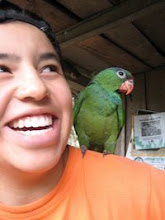Corn, or ``Maíz´´, as it is called in Spanish, is the staple food of El Salvador. It is also the staple food of the rest of Latin America, many parts of Africa and some parts of Asia. In fact, during the course of my time here in Central America, the presence of corn has been almost overwhelming in my day to day life (in a good way). As I may have mentioned before, my work placement is with a Salvadoran non-governmental organization in the field of sustainable agriculture and food security. From what I can tell, my work here basically involves becoming a corn farmer.
At the moment, in the rural communities with which my organization works, farmers buy hybrid corn seed to plant every year. Hybrid corn is nice because it is bred to give high yields, resistance to diseases and other desirable characteristics. Due to a biological phenomenon known as hybrid vigour, the crossing of two inbred corn lines results in the first hybrid generation showing the best of the parents´ most desirable characteristics. Breeders manipulate the pollination process of inbred lines in order to achieve this. However, in the second generation, mediocre characteristics of the grandparent corn resurface, so yield and disease resistance decrease. What this means is that seeds collected and replanted by farmers for the next year do not become particularly productive plants, so the farmers inevitably become dependent on purchasing the seed every agricultural cycle. In addition to this, they also must purchase fertilizers, insecticides and herbicides that go along with the hybrid seed, and as you might imagine, the costs add up quickly. Why do farmers buy hybrid seed? Apparently, seed companies operate intense propaganda schemes that lead to the notion that hybrid corn is intrinsically better than open pollinated varieties. Similarly, transgenic (genetically modified) corn is also on the rise. It is the most expensive seed available, and also thought to be better than other varieties. Transgenic corn also requires chemical inputs (fertilizers etc), and it is genetically engineered to not produce viable seed for replanting, so again, farmers depend on buying the seed every year.
The overarching goal of my job is to find sustainable alternatives to all of these practices. My main project is to figure out ways to productively breed Creole Corn (a non-hybrid variety), or to put it more specifically, to figure out how to select the best, strongest, healthiest seed for replanting next year. My first assignment at work was the reading of a 400 pg manual in Spanish entitled ``
El Maíz en los Tropicos: Mejoramiento y Produccion´´ (Corn in the Tropics: Improvement and Production). Slow reading but fun stuff. Since then, I have done lots of online research, and put together a short manual with descriptions of possible techniques. In the upcoming months, I will be going into the field and testing out the theory. Hopefully the experiments will then be the basis for development of solid breeding methods that can be used by future farmers as an alternative to buying expensive hybrid seed and related inputs. My biggest worry aside from actually carrying out this project, is making sure that it can be sustainable after I leave, given that I´m here for only one harvest. A big goal of mine therefore, is to try to work very closely with farmers who know a lot more about planting corn than I do, incorporate their normal cultivation methods in the Creole Corn experiments, and through that process hopefully generate a lot of interest in the results.
And in case you thought I would gloss over the most well-known symbol of Latin American cuisine you will not be disappointed as I further describe my food adventures. I refer of course to the tortilla – the staple, the bread, the unfaltering companion to all other meals, the beginning and the end, the little yellow disc of warm toasted goodness. Between the tortillas, the pupusas, the elotes (corn on the cob), the atols (hot corn drink), the tamales (doughy corn dish) and other popular meals, I rapidly realized that not only am I turning into a corn farmer, but I am in fact, turning into corn. But I digress… The tortilla! The tortilla is a corn-based dish. It is an unleavened circular bread that is hand-flattened by women everywhere I have so far visited. Unlike the North American tortilla, it is slightly thicker and much smaller. Within my first week of cooking at home, I embarked on my very own food adventure: trial and error tortilla making. With disbelieving roommates in attendance, I started my first tortilla attempt by slowly adding water to ``harina de maíz´´ - corn flour – to reach the consistency that I had admiringly observed at street stands all over. So far so good. I rolled the dough into balls, then flattened them into discs and fried them in oil. Very tasty, but wrong! In fact, there is no need for the oil frying. Locals place tortillas on ``comals´´ - sort of like large sheets of metal, heated from below that permit tortilla-making by the dozens. Now I leave the tortilla dough on the pan at low heat, flip over a few times and then eat the tortillas hot with veggies, meat, and sauce. My roommates now insist that I am genetically predisposed to know how to cook tortillas.


